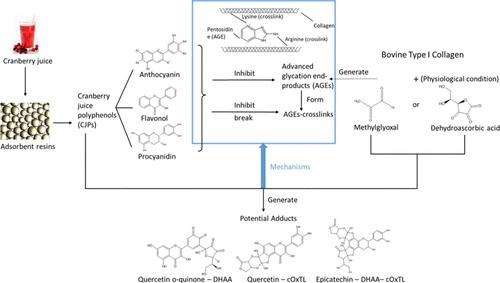当前位置:
X-MOL 学术
›
J. Agric. Food Chem.
›
论文详情
Our official English website, www.x-mol.net, welcomes your
feedback! (Note: you will need to create a separate account there.)
Cranberry Juice Polyphenols Inhibited the Formation of Advanced Glycation End Products in Collagens, Inhibited Advanced Glycation End Product-Induced Collagen Crosslinking, and Cleaved the Formed Crosslinks
Journal of Agricultural and Food Chemistry ( IF 5.7 ) Pub Date : 2022-12-01 , DOI: 10.1021/acs.jafc.2c06502 Haotian Chang 1 , Elizabeth Johnson 2 , Christina Khoo 2 , Weixin Wang 3 , Liwei Gu 1
Journal of Agricultural and Food Chemistry ( IF 5.7 ) Pub Date : 2022-12-01 , DOI: 10.1021/acs.jafc.2c06502 Haotian Chang 1 , Elizabeth Johnson 2 , Christina Khoo 2 , Weixin Wang 3 , Liwei Gu 1
Affiliation

|
Collagens in the human skin are susceptible to glycation due to their long half-life of about 15 years, accumulating advanced glycation end products (AGEs). The formation of AGEs and the subsequent AGE-induced collagen crosslinking are major factors for skin aging. The objective of this study was to determine the capacity of cranberry juice polyphenols (CJPs) and their fractions to inhibit collagen glycation and to break AGE-induced crosslinks in collagens. Concentrated cranberry juice was extracted to obtain the CJP, which was further fractionated into an ethyl acetate fraction, water fraction, 30% methanol (MeOH) fraction, 60% MeOH fraction, MeOH fraction, and acetone fraction. CJPs and their fractions contained different ratios of anthocyanins, procyanidins, and flavonols. All the fractions significantly inhibited collagen glycation assessed with the collagen–methylglyoxal (MGO) or collagen–dehydroascorbic acid (DHAA) assays. The ethyl acetate fraction and 60% MeOH had the lowest IC50 values in the collagen–MGO and collagen–DHAA assays. The methanol fraction (IC50 = 0.52 μg/mL) and acetone fraction (IC50 = 0.019 mg/mL) had the lowest IC50 values in the inhibition and breakage of AGE-induced collagen crosslinking, respectively. The ethyl acetate fraction significantly scavenged the highest amount of MGO and DHAA after incubation compared to the other fractions. Results suggested that procyanidins were the most effective antiglycation agent in both collagen glycation assays, followed by flavonols and anthocyanins. High-performance liquid chromatography–electrospray ionization─tandem mass spectrometry showed that the reactions of DHAA with quercetin or epicatechin formed several adducts with unreported proposed structures. This study suggested that CJPs may be used as active ingredients in cosmetics to prevent skin collagen glycation and crosslinking and to break the formed crosslinks.
中文翻译:

蔓越莓汁多酚抑制胶原蛋白中高级糖基化终产物的形成,抑制高级糖基化终产物诱导的胶原交联,并裂解形成的交联
人体皮肤中的胶原蛋白由于其约 15 年的长半衰期而容易发生糖化,从而积累晚期糖基化终产物 (AGEs)。AGEs 的形成和随后的 AGE 诱导的胶原蛋白交联是皮肤老化的主要因素。本研究的目的是确定蔓越莓汁多酚 (CJP) 及其组分抑制胶原蛋白糖化和破坏 AGE 诱导的胶原蛋白交联的能力。提取浓缩蔓越莓汁以获得 CJP,将其进一步分馏为乙酸乙酯馏分、水馏分、30% 甲醇 (MeOH) 馏分、60% MeOH 馏分、MeOH 馏分和丙酮馏分。CJPs 及其组分含有不同比例的花青素、原花青素和黄酮醇。通过胶原蛋白-甲基乙二醛 (MGO) 或胶原蛋白-脱氢抗坏血酸 (DHAA) 测定评估,所有组分均显着抑制胶原蛋白糖化。乙酸乙酯馏分和 60% MeOH 具有最低的 IC胶原蛋白-MGO 和胶原蛋白-DHAA 测定中的50 个值。甲醇部分 (IC 50 = 0.52 μg/mL) 和丙酮部分 (IC 50 = 0.019 mg/mL) 具有最低的 IC 50分别抑制和破坏 AGE 诱导的胶原交联的值。与其他部分相比,乙酸乙酯部分在温育后显着清除了最高量的 MGO 和 DHAA。结果表明,原花青素是两种胶原糖化试验中最有效的抗糖化剂,其次是黄酮醇和花青素。高效液相色谱-电喷雾电离-串联质谱表明,DHAA 与槲皮素或表儿茶素的反应形成了几种具有未报道的结构的加合物。该研究表明,CJPs 可用作化妆品中的活性成分,以防止皮肤胶原蛋白糖化和交联,并破坏已形成的交联。
更新日期:2022-12-01
中文翻译:

蔓越莓汁多酚抑制胶原蛋白中高级糖基化终产物的形成,抑制高级糖基化终产物诱导的胶原交联,并裂解形成的交联
人体皮肤中的胶原蛋白由于其约 15 年的长半衰期而容易发生糖化,从而积累晚期糖基化终产物 (AGEs)。AGEs 的形成和随后的 AGE 诱导的胶原蛋白交联是皮肤老化的主要因素。本研究的目的是确定蔓越莓汁多酚 (CJP) 及其组分抑制胶原蛋白糖化和破坏 AGE 诱导的胶原蛋白交联的能力。提取浓缩蔓越莓汁以获得 CJP,将其进一步分馏为乙酸乙酯馏分、水馏分、30% 甲醇 (MeOH) 馏分、60% MeOH 馏分、MeOH 馏分和丙酮馏分。CJPs 及其组分含有不同比例的花青素、原花青素和黄酮醇。通过胶原蛋白-甲基乙二醛 (MGO) 或胶原蛋白-脱氢抗坏血酸 (DHAA) 测定评估,所有组分均显着抑制胶原蛋白糖化。乙酸乙酯馏分和 60% MeOH 具有最低的 IC胶原蛋白-MGO 和胶原蛋白-DHAA 测定中的50 个值。甲醇部分 (IC 50 = 0.52 μg/mL) 和丙酮部分 (IC 50 = 0.019 mg/mL) 具有最低的 IC 50分别抑制和破坏 AGE 诱导的胶原交联的值。与其他部分相比,乙酸乙酯部分在温育后显着清除了最高量的 MGO 和 DHAA。结果表明,原花青素是两种胶原糖化试验中最有效的抗糖化剂,其次是黄酮醇和花青素。高效液相色谱-电喷雾电离-串联质谱表明,DHAA 与槲皮素或表儿茶素的反应形成了几种具有未报道的结构的加合物。该研究表明,CJPs 可用作化妆品中的活性成分,以防止皮肤胶原蛋白糖化和交联,并破坏已形成的交联。











































 京公网安备 11010802027423号
京公网安备 11010802027423号